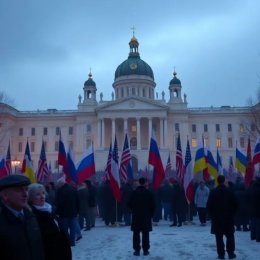- Norwich Blogs
- Blogs
- U.S. Northern Military Competition: Closing Arctic Operational Capabilities Gaps
U.S. Northern Military Competition: Closing Arctic Operational Capabilities Gaps
By Troy J. Bouffard
This piece highlights the U.S. military’s need to strengthen land-based Arctic preparedness, noting that while the Air Force and Navy have maintained legacy capabilities, newer challenges require dedicated ground force strategies. The activation of the 11th Airborne Division (Arctic) in June 2022 marks a major step, but the Department of Defense still lacks a fully defined Arctic mission, doctrine, and operational guidance to align with the 2022 National Strategy for the Arctic Region.

Disclaimer: These opinion pieces represent the authors’ personal views, and do not necessarily reflect the official policies or positions of Norwich University or PAWC.
Prior to February 2022, the Russian Federation continued to make notable progress on its Arctic strategic development priorities throughout all sectors. However, Moscow’s large-scale invasion of Ukraine not only stopped but actually degraded much of Russia’s Arctic military progress. Western cooperation rapidly paused or excluded Russian participation in many activities and organizations, including security-related activities such as the Arctic Coast Guard Forum. Gone were any hopes of potential Arctic military dialogue and cooperation between Russia and the West. Yet, it became apparent that Russia’s actions could lead to important opportunities for the West regarding issues involving the competitive continuum.
During the previous decade, Russia consistently exhibited intent and development of its Arctic land forces. In 2011, Russia formed the 200th Separate Motor Rifle Brigade (Arctic) and the 80th Motorized Rifle Brigade (Arctic) in 2014, which fell under the provisionally established fifth military district known as the Arctic Joint Strategic Command (Northern Fleet) in December 2014 and under military command of the Russian 14th Combined Arms Army (i.e., Army Corps) in 2017.[i] In late February 2024, Russia dissolved the new military district and rolled it into the new Leningrad Military District. The Russian Arctic brigades worked over the years to demonstrate[ii] its northern operational capabilities[iii] as Moscow strategically communicated their approval and pride. These developments complemented the Russian northern bastion defense[iv] and it increasingly became apparent that the Kremlin had a plan to strengthen both Arctic defense and force projection capabilities. The West understood the importance of Russia’s continued Arctic military progress and knew it had a legitimate competitor, especially when considering the basic formula for military success as ‘precision-enabled, all-domain, combat- and combined arms warfare’. Russia’s Arctic land forces – with or without naval infantry – helped fulfill the combat- and combined arms part of requirements. The United States (and allies) had a problem: Russia, at its absolute peak, had actual Arctic military superiority within definable circumstances, both quantitatively and qualitatively. No matter how short lived, this was realized as fact(ual).
For the United States, our approach to regional requirements was guided by Cold War legacy capabilities, where air/aerospace and naval operational capabilities represented significant superiority in the North over Russia. However, such thinking slowed other necessary developments. While the Air Force and Navy (sub-surface only) maintained unmatched strategic ability, it convoluted understanding regarding new operational requirements for emerging Arctic security issues, for two primary reasons. Firstly, capabilities were limited to the most extreme scenarios. Secondly, they were traditional components of North American defense requirements (i.e., different national strategies and money). To meet military readiness requirements regarding both resource and mission capabilities, geographic combatant command (GCC) strategic plans, (campaign, CONPLANs, and OPLANs), need to articulate how prioritized national security and defense mandates will be addressed through the application of military operational capabilities (ex. lines of operation) and other means (ex. lines of effort). For today’s Arctic, this is especially difficult as such requirements have never existed before for the United States.
Most U.S. defense issues are well managed by a single geographic combatant command, of which there are six and five functional combatant commands with global missions. Bureaucratically, a single GCC helps to efficiently manage priority regional issues and solutions to contested operational circumstances and geopolitical competition. However, the Arctic region has shared responsibilities through three different GCCs, (USNORTHCOM [DOD Arctic lead], USEUCOM, and USINDOPACOM), which also means three sets of strategic plans. Additionally, like any other region, requirements commonly manifest themselves in two distinct magnitudes, including expeditionary operations and Large-Scale Combat Operations (LSCO), which are very much a part of Arctic military planning. Our allies have greatly helped to shape our understanding of Arctic expeditionary operations, but informing Arctic LSCO is limited, where history only offers one instance[v] and Russia is the only great-power, Arctic military peer to the United States.
Furthermore, most military solutions to national requirements include joint level as well as service component contributions, hence the formula above. For years, USAF and USN continuing legacy capabilities appeased beltway authorities that Arctic defense requirements were being met. Without a doubt, many of their capabilities remain highly relevant to newer Arctic requirements. Yet, to even begin to meet the formula for military success though, U.S. land force Arctic operational capabilities must be established in order to provide critical operational capabilities and solutions within strategic-level plans. To that end, in June 2022, the 11th Airborne Division (Arctic) was reactivated and designated as the first Arctic unit in U.S. military history.
Although an Arctic mission has yet to be defined by the DOD, an enormous amount of progress continues to add markedly to U.S. military Arctic operational capabilities. To be clear, the 2022 White House National Strategy for the Arctic Region (NSAR) does provide a vision, but the mission that provides a military approach to the vision needs to be established, which may be provided by the upcoming DOD Arctic Strategy. Beyond that, many efforts continue without clear authorities or guidance, doctrine, or even experience, to assist, but that is an unavoidable circumstance given the absolute uniqueness of Arctic requirements. As a new national priority mission, which has never been attempted, and is still undefined, leaders and support at all levels work necessarily in parallel towards expected objectives with little authority, examples, and guidance to do so. This brings me to the main message of this article.
Russian Arctic land-force operational capabilities are now at a significantly degraded level. The 80th and 200th brigades have since deployed most of their units and equipment to Ukraine only to be obliterated. Effectively, they are no longer functional and may have been outright destroyed. Much of the progress of Russian land forces and combined arms warfare is stagnate, despite all the announcements and rhetoric to the contrary.[vi]It is not unreasonable to predict that it will be years before such capabilities exist again for Russia, even though other components still exist.[vii] Remember, it is not uncommon for Russian military capabilities and man power to exist only on paper, where it is sometimes known that a few people occupying a command building is meant to represent entire, functioning regiments.
Given their individual, leadership, and equipment performance in Ukraine, and irrespective of all reporting before and otherwise, it might be anticipated that significant time will pass before the Russian Ministry of Defense achieves respectable levels of military readiness and professionalism, or even the trust of the Kremlin again. To be fair though, Russian ability to reconstitute has been traditionally underestimated by the West. Experts with a wider understanding of Russian competition with NATO consider that Russian MoD future resurgence efforts might adopt influential military science lessons from Alexander Svechin’s theory based on attrition warfare as the means to strategic defeat of NATO through combined-arms conflict.[viii]
In any case, Russian Arctic developments were real, and observable by design. Where once Russia gained a slight edge, the United States and Western Allies now have an unforeseen, extremely valuable opportunity to close and reverse those gaps by focusing resources and efforts in those areas most in need: U.S. Army and U.S. Marine Corps land force operational capabilities. While an Arctic maritime surface presence capability is desperately needed, our western allies can likely help cover that effectively. Conversely, U.S. military land forces are massively larger than our northern allies combined (special operations and conventional forces), and they operate at expected levels and capabilities where our Arctic partners likely cannot contribute at a level necessary, especially when compared to the most dangerous potential of our main adversaries.
Once strategic-level products can be fully developed and published with the addition of resourced, vital land force solutions (including short and medium-range air defense), all other efforts – vertically and horizontally – can advance with significantly greater clarity and purpose. This opportunity to overcome competitive operational capability gaps will not happen again. When all is said and done, and Russia crawls back after its war with Ukraine to begin reconstituting its Arctic capabilities and latest developments,[ix] the United States and its allies should be able to inform Moscow that its self-proclaimed status no longer applies, and we are now the dominant Arctic military power of the region.
Troy Bouffard is the Director of the Center for Arctic Security and Resilience at the University of Alaska Fairbanks. His experience and expertise include Arctic defense and security issues with the DOD and NATO, as well as geopolitical and diplomatic Arctic affairs to include the Arctic Council and continuing research in the social and natural sciences of the Arctic.
[i] Jonas Kjellén, "The Russian Northern Fleet and the (Re) Militarisation of the Arctic," Arctic Review on Law and Politics 13 (2022).
[ii] Iona Allen, Arctic Narratives and Political Values: Arctic States, China and NATO, Nato Strategic Communication Centre of Excellence (Riga, Latvia: NATO Strategic Communications Centre of Excellence, December 2020), 110-13.
[iii] Katarzyna Zysk, Russia’s Military Build-up in the Arctic: To What End, Policy Strategy, Plans, and Programs Division (SP3), Center for Naval Analyses (Washington, DC, September 2020), 21-30.
[iv] Mathieu Boulègue, "Russia’s Military Posture in the Arctic," Chatham House, London 49 (2019): 6-10.
[v] James F. Gebhardt, The Petsamo-Kirkenes Operation: Soviet Breakthrough and Pursuit in the Arctic, October 1944, vol. 17, Leavenworth Papers, (Fort Leavenworth, Kansas: Combat Studies Institute, U.S. Army Command and General Staff College, 1989).
[vi] "Russia Announces New Combined Arms Army in Arctic to Offset NATO Expansion," Foreign Military Studies Office, updated 02 October, 2023, https://fmso.tradoc.army.mil/2023/russia-announces-new-combined-arms-army-in-arctic-to-offset-nato-expansion/.
[vii] "Russia’s Forces in the High North: Weakened by the War, yet Still a Multidomain Threat," High North News, updated 16 January, 2024, https://www.highnorthnews.com/en/russias-forces-high-north-weakened-war-yet-still-multidomain-threat.
[viii] Alexandr A. Svechin, Strategy (Minneapolis, Minnesota, 1992). First published as Стратегия, Moscow: Voennyi vestnik, 1927; Lester W. Grau and Charles Bartles, The Russian Way of War (Fort Leavenworth, Kansas: Foreign Military Studies Office, 2016).
[ix] "Полярный округ: в составе Северного флота создадут общевойсковую армию," Polar District: a combined arms army will be created as part of the Northern Fleet, Известия, updated 03 июля (July), 2023, https://iz.ru/1538203/roman-kretcul-aleksei-ramm/poliarnyi-okrug-v-sostave-severnogo-flota-sozdadut-obshchevoiskovuiu-armiiu.



